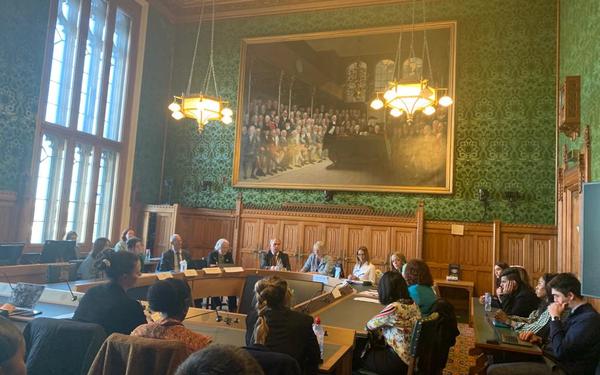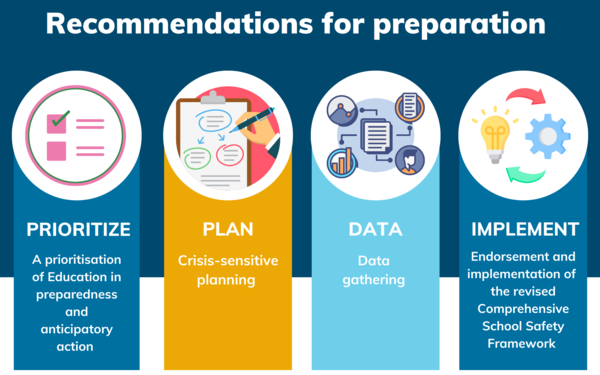Looking ahead: UK leadership on education in emergencies
Last week, our Managing Director Jane Mann was invited to speak at the launch of a new policy report on Education in Emergencies in UK parliament. The report was created by the Send My Friend Coalition, and launched with the All-Party Parliamentary Group (APPG) on Global Education. It outlines the steps the UK should take to support crisis-affected countries in building and investing in inclusive, resilient and gender-responsive education systems that can withstand all hazards.

A child’s right to education does not end and should not be suspended in times of emergency or crisis. Education in emergencies (EiE) is life-saving and life-protecting. Safe and supportive learning spaces can provide children with the skills to escape crises, build their resilience and adaptive capacity to withstand hazards, and most critically restore their hopes for a brighter future.
Jane shared her thoughts on the concrete actions we need to prevent and mitigate disruptions to children's education.
Here’s what she had to say;
“In January 2010, a 7-point earthquake hit Haiti. 230,000 people died. Later that year, a very similar 7-point earthquake hit New Zealand. 2 people died, one of a heart attack from the shock.
Both quakes were of the same, powerful magnitude and occurred on a fault line near a major population centre. But the destruction was worlds apart.
The key difference? Preparedness.
There was huge investment in preparing for quakes in New Zealand – including good construction codes – and almost no preparation in Haiti, one of the poorest nations in the world.
I lead the Cambridge Partnership for Education, part of the University of Cambridge, and we work with governments and organisations to transform national education systems – we're implementors, and we see first-hand the impact on educational continuity of a lack of preparedness.
Over the past three years, we’ve seen a global pandemic, for which education systems were not prepared, wreak havoc on education worldwide.
If you were a child in the UK, researchers estimate you lost one third of what you would have learned in one normal school year. But if you were in Uganda, models predict you lost 2.8 years of learning.
We also know that the most vulnerable children in every country experienced the greatest impact on their education – widening existing gaps.
Investing in ‘preparedness’ is the key to turning this around.
The aid budget for Haiti prior to the quake was about $900 million, the money pledged after was more than $10 billion. Shifting even just some of these resources from after the event to before would bring the overall costs down – not to mention reducing human suffering.
The recommendation to prepare sits at the heart of the Let My Friends Learn report. It calls for governments to:

When I say ‘preparedness’ in education, I’m talking about building resilient education systems. Resilient systems have the processes, structures, depth of expertise and capacity to manage sudden changes with minimum additional investment of resources and less disruption to education continuity.
At Cambridge, our approach to system strengthening to generate resilience is to focused on system analysis and system coherence. Ministries of Education need to understand how their systems are performing, which parts are already well aligned, and working well, and which parts need improvement. Having this visibility of system ‘health’ is critical to further strengthening and preparedness.
We know that data plays a vital role here. Data helps us to understand the different elements of an education system and their relationships with one another. It is critical to finding the gaps and weaknesses in the system which will be the first to break in a crisis, and to recognising those marginalised groups who will be most affected.
Through a data-led education system strengthening approach, we have an opportunity to pursue the humanitarian development nexus – bridging the gap between emergency response and long-term development.
With a rapidly growing funding gap for education in emergencies, governments and donors need to invest more, and resources need to be targeted better, at the weak spots in a system, to deliver greater return on investment.
Investing in system strengthening will not only reduce the impact of a future crisis, it will also improve education outcomes in ‘normal’ times. As CEO of the Global Partnership for Education Laura Frigenti said in Geneva:
“We cannot wait for the emergency phase to be completed before we start thinking about the education system of the future.”
In Pakistan, we’re working with the government on a set of standards to evaluate the quality of distance and digital learning programmes. This means they will have stronger remote learning initiatives in place that will help marginalised and out of schools groups now, but will also support larger scale pivots to digital learning in the case of further crises, like the devastating floods of last year.
In Ukraine, we have developed an approach to support teachers and learners affected by the war that supports displaced children now, while also preparing the government to strengthen their education system in the future – including learning maps, records and teacher development.
I think we need to stop hiding behind the terms ‘crisis’ and ‘black swan event’.
Armed conflicts and the impacts of climate change are causing disruption to education systems worldwide. We’re seeing climbing, record numbers of refugees.
In calling something a ‘crisis’, we are suggesting it is unpredictable. We are absolving ourselves of responsibilities.
We need instead to see these as predictable events which might happen. Risks. And, as with all good risk management, we must take anticipatory actions to mitigate those risks: system-strengthening preparation.
It is a dereliction of duty to ignore the predictability of shocks around the world. It is irresponsible not to prepare.’
The report on education in emergencies makes recommendations for actions the UK can take to prevent and mitigate disruptions to children and young people’s education/learning support. You can read the full report here.




